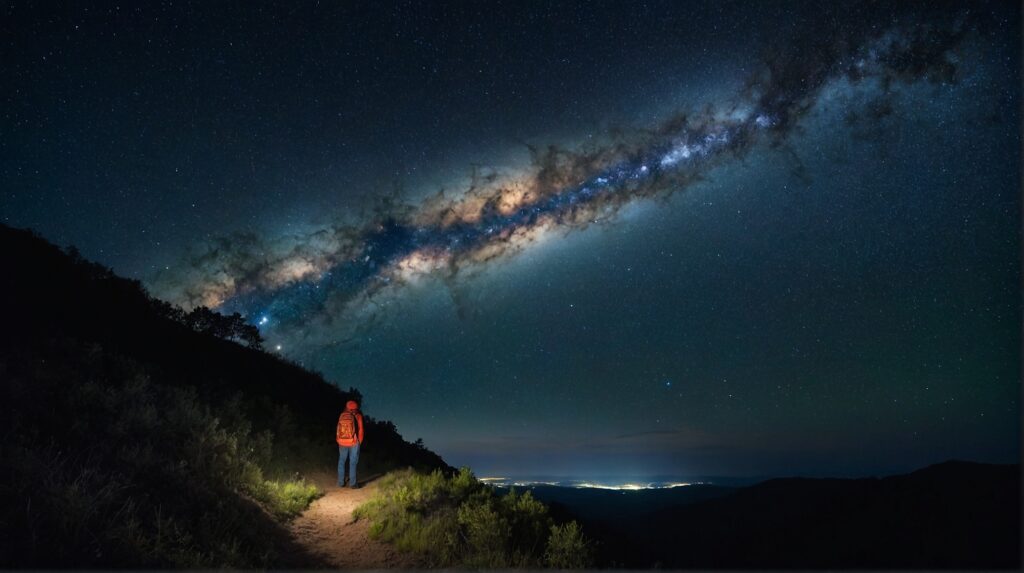Preface
Stories have long held a pivotal role in the journey of human evolution, weaving together the threads of knowledge, imagination, and understanding that define our species. From the cryptic equations of physicists to the ancient myths of civilizations past, storytelling has transcended mere entertainment to become a fundamental pillar of human cognition and culture. This essay delves into the rich interplay between the abstract narratives of science and the vivid tales of mythology, exploring how storytelling reflects our relentless quest to comprehend the universe and our place within it.
As we journey through this exploration, we unravel the ways in which stories—be they grounded in the rigorous formulations of mathematics or the rich strands of cultural lore—serve as our gateway to the cosmos, offering insights into the profound mysteries that pervade our existence. We discover how narratives, in all their forms, foster a deep connection with the world around us, allowing us to transcend the boundaries of our individual perspectives and engage with the collective human experience.
Unlocking the Universe through Story

Scientists’ conversations are often peppered with specialized terminology and gilded with a host of complex equations. Such discourse is far from the engaging tales typically shared around a campfire, captivating the audience’s attention. However, for those adept in deciphering these mathematical languages and technical expressions, the narratives unveiled are profoundly compelling. In November 1915, Albert Einstein, fatigued yet on the brink of finalizing his general theory of relativity, applied his formulae to elucidate the long-standing puzzle of Mercury’s orbital deviation from Newtonian expectations. The realization that his equations accurately described this anomaly caused him such emotional stirrings that he felt palpitations. After nearly ten years of navigating through the intricate maze of mathematics, this breakthrough was akin to a mariner sighting land after a perilous voyage—it signified that Einstein’s audacious journey had reached a fruitful conclusion, providing a fresh lens through which to understand our universe.
Such monumental discoveries are rare, yet even lesser scientific revelations can evoke a similar exhilaration, fostering a profound connection with the cosmos. This is the essence of the narratives hidden within abstract mathematics and specialized language. They offer an intimate glimpse into the universe or aspects of it, chronicling its inception, evolution, and metamorphosis. These mathematical stories, validated by observation and experimentation, invite us into communion with a mysterious and magnificent cosmos, unveiling realms of reality that are startlingly novel and often entirely unexpected.
Parallel to this, the stories we have shared through spoken and written language for millennia serve a similar purpose. Storytelling liberates us from our singular viewpoints, allowing us, if only temporarily, to see the world through the eyes and imagination of another. This narrative “flight simulator” transports us into the unique universes that reside in the minds of others. As Joyce Carol Oates eloquently puts it, reading is a unique gateway through which we “slip, involuntarily, often helplessly, into another’s skin; another’s voice; another’s soul,” granting us access to consciousnesses beyond our own. Without the vehicle of storytelling, the intricate nuances of other minds would remain as inaccessible as the quantum realm absent the knowledge of quantum mechanics.
The Imperative of Narrative

Could the unique power of storytelling have evolutionary implications? Scholars have suggested that our ascendancy as a species owes much to our profound social nature. Our ability to live, work, and thrive in groups—though not without discord—has fundamentally altered the dynamics of survival. It’s not merely about finding safety in numbers but about innovating, participating, delegating, and collaborating collectively. Central to this sophisticated social existence is our capacity to absorb and comprehend the vast spectrum of human experience through stories. We frame our understanding of human events and memories predominantly through narratives, enabling a form of collective life that would otherwise be inconceivable. Narratives allow us to traverse the full length of human behavior, from societal norms to egregious violations, exposing us to the entire breadth of human motives, from the noblest aspirations to the most deplorable deeds. We are introduced to the range of human conditions, from exultant triumphs to the deepest sorrows. Through storytelling, the social landscape becomes richer, more navigable, and brimming with possibilities, fostering a deep-seated desire to comprehend our world not only through our own experiences but also through those of others, including fictional characters. Whether conveyed through myths, stories, fables, or dramatized daily encounters, narratives are the linchpin of our inherently social nature. While mathematics allows us to connect with different realities, storytelling enables us to connect with different minds.
Even as the traditional tales of yesteryear might seem distant, the allure of morality stories and space epics, which blend heroic adventure with ethical contemplation, continues to captivate us. For our ancestors, the essence of life and community was encapsulated in shared stories, a tradition that, though diversified, remains a cornerstone of how we conceptualize our world today. This reliance on narrative as a primary mode of understanding is no coincidence, considering our evolutionary heritage from beings whose only source of knowledge was personal experience. Such experiences, whether navigating modern airports or coordinating communal hunts on the ancient African plains, inherently come to us as narrative-like sequences. If we were endowed with the fantastical ability to see the world at the level of particles or quantum wave functions, perhaps our internal narratives and memories might adopt these forms. However, given our human senses, our palette of experiences is intrinsically narrative, and accordingly, our minds have evolved to map the universe in stories, painting a vivid and complex picture of existence through the art of storytelling.
Although the allure of narrative form is universal, the substance it conveys varies extensively, transcending mere human interactions. This divergence is starkly evident in scientific narratives, where the journey of humanity’s quest to unlock the mysteries of the cosmos is framed within the drama and heroics akin to mythical sagas. However, the criteria for evaluating the scientific merit of these narratives are distinctly different from those applied to our personal or collective odysseys. Science’s core mission is to unveil an objective reality, necessitating that its narratives adhere to rigorous standards of logic and withstand the test of replicable experimentation. This commitment to minimizing subjectivity enables science to uncover truths that are applicable not just to humanity but potentially across the cosmos. For instance, Schrödinger’s groundbreaking equation in quantum mechanics offers unprecedented insights into the behavior of electrons, far surpassing the descriptive precision of any human-centered narrative. Yet, this mathematical rigor offers little reflection on Schrödinger’s personal story or our collective human experience, a trade-off science embraces to yield insights of universal relevance.
Contrastingly, narratives centered around human or fictional characters serve to illuminate the complex, subjective landscape of human existence. They magnify our collective and individual aspirations, fears, and joys, offering a lens through which the boundless spectrum of human experience can be explored. Through the medium of story, augmented by the power of language, we transcend the confines of our individual experiences, gaining a deeper appreciation for the essence of our humanity and the complexities of social coexistence.
The impulse to tell stories, whether grounded in reality or imagination, whether symbolic or literal, is a fundamental human trait. Our perception of the world, informed by our senses, drives us to seek, invent, and interpret patterns, imbuing our existence with coherence and possibility. Stories serve as the vehicles through which we communicate these patterns, playing a crucial role in how we navigate our lives and comprehend our place in the universe. They offer a rich canvass of human interaction and experience, enriching our responses and shaping our actions. In a distant future, should we encounter beings from other worlds, our scientific narratives might present truths they too have uncovered, offering little novelty. However, our human stories will unveil the depth of our identity, sharing the unique essence of what it means to be human.
Cultural Myths and Expanding Realities

Within the scientific community, research gains prominence by clarifying perplexing phenomena, resolving complex theoretical dilemmas, or enabling previously impossible achievements. While most scientific advancements remain within the domain of specialists, a select few transcend this boundary and profoundly influence broader cultural understanding. Typically, these significant breakthroughs address fundamental questions about the universe, time, and the nature of space, offering insights that can dramatically alter our perception of reality. For instance, the understanding that our planet orbits an ordinary star, born from the colossal expansion of primordial space, profoundly influences my sense of our place in the cosmos. The realization that time flows differently for each individual, depending on their movement through space, fascinates me without end. Moreover, the possibility that our perceived three-dimensional world might just be a sliver of a much larger spatial reality fuels my imagination.
Similarly, throughout millennia, cultures have crafted stories that have risen to prominence, deeply affecting their communities’ worldview. These stories, or myths, are revered narratives that employ supernatural elements to explore existential queries, including the origins of life, the significance of rituals, and the imposition of order upon the world. Through their endurance, universal appeal, and foundational explanations, myths constitute a shared heritage—a rich mosaic of tragedy and triumph, chronicles and fantasies, adventures, and introspections that define a people and shape a society.
Scholars have long sought to unravel and interpret myths. In the early twentieth century, anthropologist Sir James Frazer suggested that myths originated as attempts to rationalize life’s mysteries and the natural world’s wonders as perceived by ancient societies. Psychologist Carl Jung advanced that myths express universal aspects of the human experience through archetypes—innate patterns embedded within the unconscious mind. Joseph Campbell introduced the concept of the “monomyth,” a universal narrative framework depicting a hero’s journey from a call to adventure, through trials and transformations, to a triumphant return home, enriching our collective understanding of reality. This overarching narrative becomes apparent not through individual myths but by examining the collective mythology of entire traditions, weaving a story that spans from the creation of the world to its eventual end. Linguistic, genetic, and archaeological evidence suggests that these narrative similarities can be traced back to an ancient mythology originating in Africa, possibly as far back as one hundred thousand years ago, highlighting a deep-rooted connection between our scientific explorations and cultural storytelling in shaping our understanding of reality.

The quest for a universal explanation of myths, attractive for its promise of unveiling the core principles that shaped our ancient heritage, encounters a major hurdle: the intricate pattern of human existence, woven through the murky corridors of history, resists simplification into a single narrative. However, our exploration need not aim for exhaustive explanations. Karen Armstrong, in her concise analysis, suggests that myths primarily emerge from our confrontation with mortality and the dread of annihilation. This perspective serves as a pilot, guiding us through the labyrinth of human storytelling.
This preoccupation with peril, death, and ultimate ruin begs the question: Why do these themes dominate our mythological landscapes? Conflict and adversity are the lifeblood of narrative; devoid of these elements, storytelling would lose its vitality. When merged with myth’s foundational concerns—such as the origins of peoples and places, and the justifications for cultural norms—the inherent tension in narratives is amplified to its zenith. This narrative escalation seems inevitable. By the advent of language and storytelling, humanity had already transcended the immediacy of the present, navigating memories of the past and projections of the future with dexterity. This capacity enabled us to plan, collaborate, anticipate, and remember, bringing tangible benefits but also confronting us with the permanence of loss. The unerring pattern of life’s end becomes a cornerstone of our awareness. Life and death, inextricably intertwined, stand as dual aspects of our existence. Contemplation of beginnings naturally evokes thoughts of endings; to ponder the essence of living is to confront the void of non-existence. Given the omnipresence of death, often sudden and inexplicable, its thematic prominence in our mythic narratives is unsurprising, reflecting humanity’s perennial engagement with its own mortality and the eternal cycle of creation and destruction.
Then, in crafting ancient myths, why do storytellers often feature beings like manic giants, fire-breathing serpents, or bull-headed men, rather than sticking to more realistic terrors? Cognitive scientists offer insights into this question. For an idea to capture our attention, linger in our memory, and be passed on, it must strike a delicate balance: novel enough to surprise us but not so far-fetched that we dismiss it outright. Such concepts hit what’s termed a “cognitive sweet spot” when they are minimally counterintuitive, deviating from our entrenched expectations in one or maybe two aspects. Consider the notion of invisible people: it’s acceptable as long as invisibility is their sole extraordinary trait. This principle aligns with the grand themes of myth where characters loom larger than life yet are constructed from the human psyche’s minimally counterintuitive elements. It’s hardly surprising, then, that these characters, while perhaps possessing abilities beyond our wildest expectations, exhibit physical appearances, thought patterns, and personality traits that feel strikingly familiar to us.
Language acts as a crucial catalyst in the generation of myths, offering a vast palette for creativity. With the ability to articulate the characteristics of everyday phenomena—like the fury of storms, the blaze of fires, the stealth of serpents—language enables an expansive narrative freedom, allowing for inventive combinations. The conceptual leap from inanimate rocks and articulate humans to speaking stones and towering giants illustrates how language empowers us to envision a plethora of unexplored possibilities. Such imaginative versatility not only sparks innovation but also equips minds to approach familiar challenges from fresh perspectives, ultimately leading to the ability to transform and command our environment.
Our inherent theory of mind, the instinct to attribute agency and consciousness to the entities we encounter, fuels mythmaking as well. This propensity extends beyond human interactions; we naturally infer intentions and emotions in animals, attributing to them a semblance of mindful action. As outlined by psychologist Justin Barrett and anthropologist Stewart Guthrie, this tendency can lead us to overinterpret signs of agency, a trait that, from an evolutionary standpoint, often serves a protective function. Erring on the side of caution, such as mistaking a benign shadow for a potential predator, typically poses less risk than the converse—underestimating real threats. This evolutionary bias towards over-attribution of agency enhances survival, encouraging a vast repertoire of imagined interactions within our environment.
This imaginative over-attribution, coupled with the linguistic ability to blend reality with fantasy, enriches our narrative toolkit, enabling the creation of captivating myths. These stories, populated with characters possessing extraordinary, albeit minimally counterintuitive, traits, seize our attention and facilitate their passage through cultural memory. By intertwining language’s descriptive power with our interpretive predispositions, myths explore complex social and existential themes, reflecting our ancestors’ attempts to make sense of the world around them. Through these narratives, our forebears navigated their realities, laying the groundwork for the emergence of one of humanity’s most profound cultural constructs: religion.
Conclusion
Through our journey from the origins of language and myth to the pinnacle of scientific discovery, we have traversed a landscape where narrative serves as the bridge between the known and the unknowable, the mundane and the divine. In the dominion of science, stories of equations and experiments guide us to a deeper understanding of the universe’s fundamental truths, while myths and tales from our cultural heritage imbue our lives with meaning, connecting us to the myriad forms of existence that populate our collective imagination.
In this interplay between the analytical and the allegorical, we find that stories are not merely a means to an end but the very essence of our quest for knowledge and understanding. They are the lens through which we perceive the complexities of life and the universe, a lens that shapes our reality and our dreams. As we continue to navigate the vast expanse of the known and the yet-to-be-discovered, let us cherish the narratives that have illuminated our path, for they are the compass by which we chart our course through the cosmos.
It is my hope that you have enjoyed this story, a narrative woven from the fabric of human curiosity and the desire to unravel the mysteries of our existence. In the stories of mathematics and myth, we find not only the answers to age-old questions but also the questions themselves, ever-evolving and ever-inspiring, a testament to the indomitable spirit of inquiry that defines us as a species.







